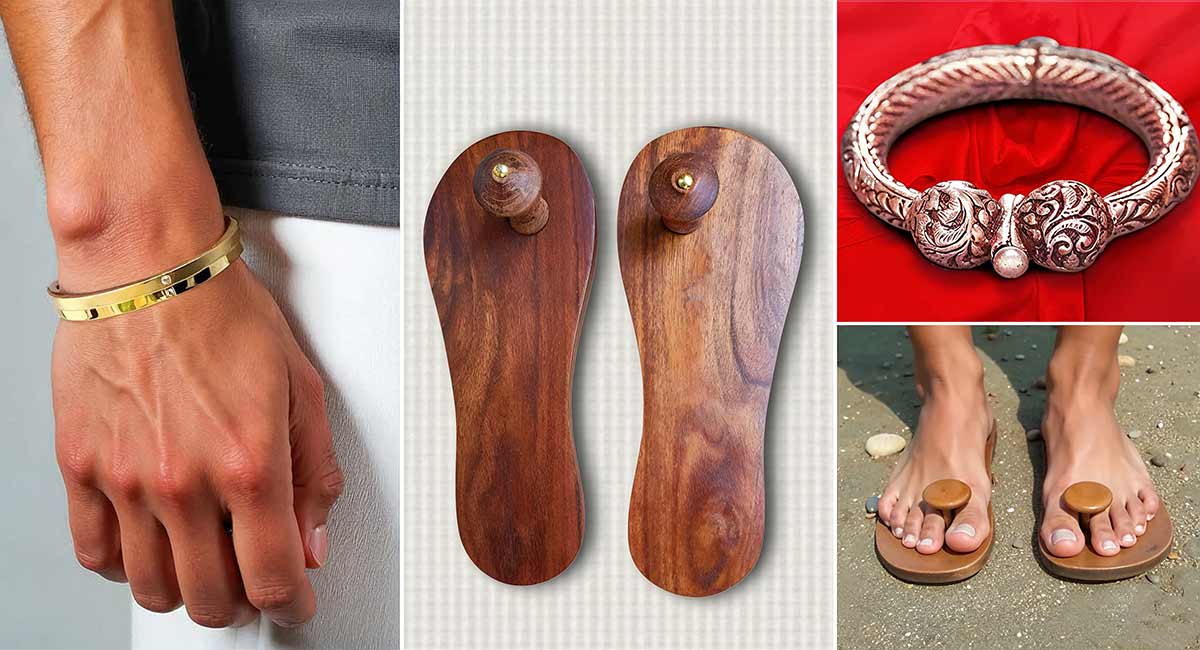Men’s Accessories: Kada to Khadau, Perfected
When we think of fashion accessories, we often focus on women’s jewelry, bags, or shoes. However, men’s fashion accessories have also played an essential role in enhancing personal style and cultural identity, particularly in regions like Odisha, India. These accessories, which range from traditional wristbands (Kada) to boots (Khadau), are not just fashion pieces but also exhibit workmanship and cultural value that echo Odisha’s rich past.
This blog examines the evolution and cultural importance of Odisha’s distinctive men’s accessories: Kada (wristband) and Khadau (traditional footwear).
Kada: A Symbol of Strength and Identity
The Kada, or a traditional metal wristband, is a prominent accessory in the cultural wardrobe of men in Odisha. It has a long history of being integral to the Odia community’s cultural and spiritual identity. Although it has spread across different parts of India, its roots in Odisha run deep.
Cultural Significance
In Odisha, the Kada is more than just a piece of jewelry; it represents fortitude, self-esteem, and a sense of defense. Men of all ages wear the Kada, and its significance extends beyond fashion. For many, the Kada is considered an amulet that protects the wearer from evil forces. It is thought to have spiritual energy and act as a continual reminder of one’s origins, obligations, and the need to maintain honor.
The kada often carries the imprint of the wearer’s family heritage and is considered a mark of identity. Many Odia households cherish it for its sentimental value, as families frequently pass it down through generations.
Designs and Materials
Traditionally, Kada bracelets are made from metals like silver, iron, and sometimes brass, depending on regional variations and personal preferences. Artisans highly value Silver Kada for its purity and craftsmanship. The designs are intricate, often featuring engravings and motifs inspired by nature, religion, or the temple architecture of Odisha.
The Kada has recently evolved to include modern designs, such as stainless steel, copper, and leather. However, the traditional Kada remains a significant accessory, especially for weddings, festivals, and religious occasions, reflecting a blend of tradition and modernity.
Kada in Rituals
The kada holds a ceremonial place in many Odia rituals. For instance, during weddings, the groom may receive a kada as a blessing from the elders. In some families, people wear the kada during religious ceremonies, such as daily worship or rituals, to invoke divine protection. It is often worn in conjunction with other ornaments, such as necklaces and rings, making it a key component of traditional attire.
Khadau: Footwear with Historical Roots
Khadau is a traditional form of footwear that has been an integral part of Odisha’s rich cultural heritage for centuries. Kings, priests, and warriors in Odisha once widely wore Khadau, which artisans crafted from wood or leather, and people in the region still consider it a symbol of cultural pride.
Cultural Significance
The Khadau has always held symbolic significance. In many temples across Odisha, priests and devotees wear wooden Khadau to show their reverence for the gods and maintain the sanctity of the temple environment. The Khadau represents humility, simplicity, and devotion, making it an essential accessory in religious practices.
In traditional Odia culture, people believe that wearing Khadau connects the wearer to their ancestors and cultural heritage. Many Odia families hold the Khadau in high regard, preserving it as a family heirloom, especially those made with intricate designs.
Designs and Materials
Historically, artisans crafted Khadau from wood, featuring varied designs that reflected the region’s influences. They often carved the wooden base to fit the contours of the foot, making it comfortable for extended periods of use. They added leather straps for fastening and durability. Designers have incorporated synthetic materials in modern versions, but the classic design still dominates.
In addition to its simple design, Khadau is adorned with elaborate embellishments, such as beads, mirrors, or metals, and is often worn on special occasions, like festivals and weddings.
Khadau in Modern Fashion
While Khadau was once considered purely functional and traditional, it has seen a resurgence in contemporary fashion. Today, men wear it during religious ceremonies and as a statement of cultural pride and tradition. Many Odia men prefer wearing Khadau during important events, such as weddings, religious festivals, or cultural programs, where it becomes a conversation piece, demonstrating their connection to their heritage.
Khadau has also found its place in modern fashion, particularly among designers reviving ancient craft forms and traditional styles. As part of this revival, Khadau has evolved into a more sophisticated accessory, often combined with contemporary designs and materials. The fusion of traditional craftsmanship with modern styling has made it a favorite among men who want to wear a piece of history with a twist.
The Fusion of Tradition and Modernity
The beauty of men’s accessories, such as Kada and Khadau, lies in their ability to adapt to modern trends while preserving their cultural essence. Odisha’s artisans have experimented with materials and designs, creating functional yet aesthetically pleasing accessories.
While cultural practices deeply rooted in the traditional Kada and Khadau, people now incorporate them into everyday fashion. Contemporary fashion houses in Odisha and across India are taking inspiration from these conventional accessories, blending them with modern aesthetics to appeal to a global audience. These accessories have become more versatile, offering options for casual, formal, and festive occasions.
A Reflection of Heritage and Identity
The Kada and Khadau are more than just accessories; they symbolize Odisha’s rich cultural heritage. These accessories serve as a bridge between the past and the present, connecting generations and preserving tradition. As global fashion trends evolve, the significance of these traditional accessories remains as a reminder of one’s cultural roots and a timeless style statement.
For men in Odisha and beyond, wearing the Kada and Khadau affirms identity, pride, and heritage. It offers a unique way to express individual style while honoring traditions. Whether as a symbol of strength or a representation of devotion, these accessories continue to shine brightly in the ever-changing world of fashion.


